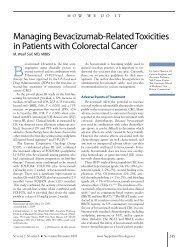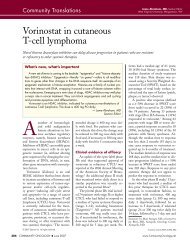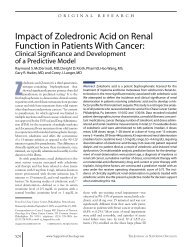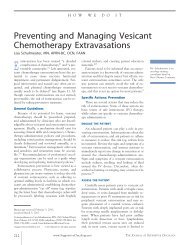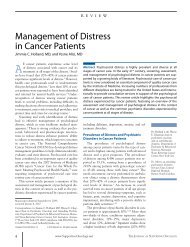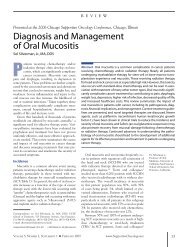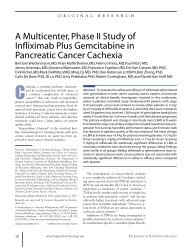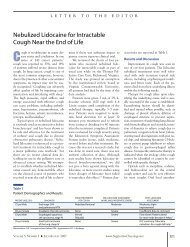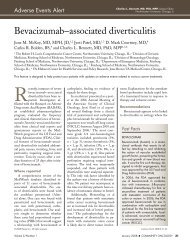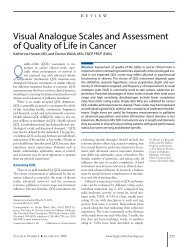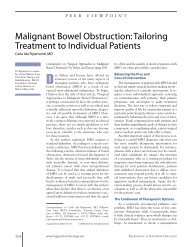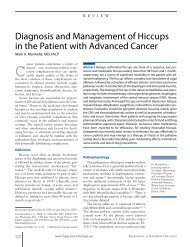Volume 9 Number 3 March 2012 - Oncology Practice Digital Network
Volume 9 Number 3 March 2012 - Oncology Practice Digital Network
Volume 9 Number 3 March 2012 - Oncology Practice Digital Network
You also want an ePaper? Increase the reach of your titles
YUMPU automatically turns print PDFs into web optimized ePapers that Google loves.
Letters<br />
Case Letter<br />
Extramedullary BCR-ABL positive<br />
T-lymphoblastic leukemia in a patient<br />
with chronic myelogenous leukemia<br />
Mylene Go, MD, Le Wang, MD, PhD, JinMing Song, MD, and Rene Rubin, MD<br />
Department of Hematology and <strong>Oncology</strong>, Drexel University, Philadelphia, PA<br />
The introduction of imatinib has significantly<br />
improved outcomes in patients<br />
with chronic myelogenous leukemia<br />
(CML). Before the Food and Drug Administration<br />
(FDA) approved imatinib for leukemia in<br />
2001, progression from chronic phase to CML<br />
blast crisis was almost inevitable in the absence of<br />
allogeneic stem cell transplantation. However, in<br />
the recent update of the IRIS trial, 93% of patients<br />
who received imatinib defied the natural history of<br />
the disease progression from a relatively protracted,<br />
benign chronic phase to the accelerated<br />
phase, and then the terminal blast phase. 1 CML is<br />
an early stem cell disease, so its blast transformation<br />
may be myeloid, lymphoid, or of undifferentiated<br />
nature. Fifty percent of blast transformation<br />
has myeloid blast phenotype and 25% has lymphoid<br />
phenotype, of which most are of B-cell<br />
lineage. T-cell blast crisis is rare and associated<br />
with poor prognosis. To date, there are a few case<br />
reports on precursor T-cell blast crisis, but none<br />
are as interesting as the current case about the<br />
demonstration of predominantly extramedullary<br />
nodal T-cell blastic transformation while the bone<br />
marrow remained in chronic phase CML.<br />
Case report<br />
A previously healthy 59-year-old black man presented<br />
with a 1-month history of fatigue, weight<br />
loss, drenching night sweats, and enlarging axillary<br />
and cervical adenopathy. On admission, the<br />
results of a complete blood count test showed that<br />
he had profound leukocytosis, with a total white<br />
blood cell count (WBC) of 255,000 cells per<br />
Manuscript received January 7, <strong>2012</strong>; accepted February 7, <strong>2012</strong>.<br />
Correspondence to: Mylene Go, MD, Division of Hematology<br />
and <strong>Oncology</strong>, Drexel University College of Medicine,<br />
245 N 15th Street, MS 412, Philadelphia, Pennsylvania 19102;<br />
e-mail: mylenego88@yahoo.com.<br />
Disclosures: None of the authors had any disclosures to make.<br />
microliter, which was comprised predominantly of<br />
neutrophils in different stages of maturation and<br />
blasts accounting for less than 2% of the total<br />
WBC. Initial laboratory findings showed a hemoglobin<br />
count of 9.4 g/dL, normocytic anemia with<br />
a mean corpuscular volume of 92 fL, leukocytosis<br />
with 54% neutrophils, 18% basophils, 6% lymphocytes,<br />
2% monocytes, 3% metamyelocytes,<br />
15% myelocytes, and 2% blasts (Figure 1). The<br />
patient was treated with hydroxyurea and supportive<br />
care measures, and achieved a nice reduction in<br />
his white blood cell count.<br />
A physical examination, also at admission, revealed<br />
multiple 2-3 cm (diameter), palpable, fixed,<br />
nontender bilateral cervical, axillary, and inguinal<br />
adenopathy and hepatomegaly, and a markedly<br />
enlarged spleen. A computed tomography scan<br />
showed extensive lymphadenopathy in the patient’s<br />
neck, mediastinum, and hilum axillary, with<br />
bulky retrocrural and inguinal lymphadenopathy<br />
and moderate hepatosplenomegaly. The patient<br />
underwent a left inguinal lymph node excisional<br />
biopsy (Figure 2) and the results of a flow cytometry<br />
analysis showed extramedullary T-lymphoblastic<br />
transformation with 86% positive for CD34,<br />
CD13, CD2, CD5, CD7, and terminal deoxynucleotidyl<br />
transferase (TdT), and negative for<br />
myeloperoxidase. He had an abnormal male<br />
52,XY karyotype with the identification of<br />
the Philadelphia (Ph) chromosome translocation<br />
at t(9;22) in one out of four metaphases<br />
and numerous other chromosomal changes,<br />
5,7,8,-9,10,1319. No clonal T-cell<br />
or immunoglobulin heavy gene rearrangement<br />
was detected. A bone marrow biopsy revealed<br />
100% cellularity with occasional micromegakaryocytes.<br />
Fewer than 5% of blasts detected in<br />
the flow cytometry analysis were positive for<br />
Commun Oncol <strong>2012</strong>;9:102-105 © <strong>2012</strong> Elsevier Inc. All rights reserved.<br />
doi:10.1016/j.cmonc.<strong>2012</strong>.02.004<br />
102 COMMUNITY ONCOLOGY <strong>March</strong> <strong>2012</strong> www.Community<strong>Oncology</strong>.net



